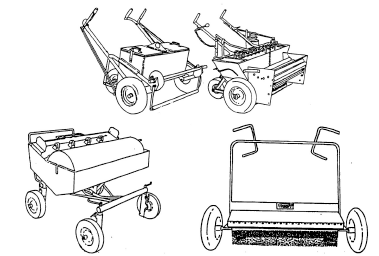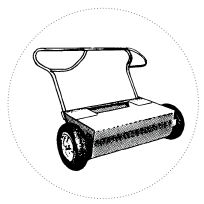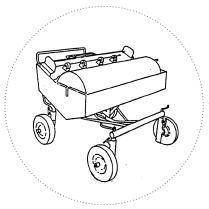The two principal types of felt layers used are:
- The dry layer which requires a person to mop in front of it.
- The combination layer, which spreads asphalt onto the deck as it lays the felt.
The combination felt layer has many variations. In some units, the asphalt is applied by means of gates or valves. With others, such as the rotary felt layer (a stationary unit), the asphalt is applied directly to the felt by means of a drum.
Some layers are only suitable for working on level or nearly level roofs. Others can be adapted to sloped roofs by means of adjustable legs. However, the greater the slope, the less practical the use of an automatic felt layer.
CAUTION: Because a roofer walks backward while operating a felt layer, they must exercise extreme care to avoid backing into curbs, projections, or even off the roof. A layer should never be operated without approved barricades at roof openings and perimeters.
When using any mechanized equipment on a roof, the roofer should always be sure that they can control the machine so that it will not roll off the roof. Never operate a felt layer within 3 m (10 ft) from the roof edge.
Felt Laying Machines
There are three basic types of mechanical asphalt dispensers that are used:
- Combination felt layer
- Mini-mopper
- Roller-type felt layer

2.2.1.1 Combination Felt Layer
The combination felt layer is a combination asphalt dispenser and felt layer. A roll of felt is placed on the rolling rod of the machine, and the felt is pulled through the bottom roller so that it comes into contact with the asphalt as the machine moves.

Some felt machines are operated by pulling them backward; others are pushed forward. The most commonly used type is the backward pull model. The flow of asphalt is regulated by ten and twelve valves located at the top front of the machine, which can be adjusted to dispense the required amount of asphalt per square. Valves can be shut off for strip-mopping, or one-third of the valves can be closed for laying a straight three-ply roof. In this way no asphalt is applied to the bare roof deck. A foot lever is used to open the valves, and a hand lever on the handle of the machine is used to close them. The flow of asphalt is spread evenly by means of a chain mesh bar at the bottom of the machine.
Most machines have lubrication dispensers on the two side wheels to keep asphalt from sticking to the wheels. Dirty wheels will tear up newly laid felt and will make pulling the machine very difficult.
Operating a Combination Felt Layer
When first starting the felt machine, remember that all the valves are “frozen” shut from the cold asphalt. Be sure that the asphalt is hot enough to “thaw” the valves and flow easily. It is important to test the machine in an area first.
Felt layer machines normally take two people to operate. To start the first course, depress the foot lever to start the flow of asphalt. Your co-worker, the roll setter, holds the end of the felt, placing it on the ply line, until the machine is far enough down the roof so that the felt will not be pulled out of place. The roll setter then uses a stiff broom, squeegee, or T-pipe to force the air pockets out of the felt and ensure adhesion. The roll setter also watches for any obstacles that you may not see or be aware of. The roll setter is also in charge of:
- Cutting the felt when reaching an obstacle or the end of the roof.
- Inserting a new roll of felt and threading it through the machine when necessary.
NOTE: When placing a roll of felt, you should not place the machine over any asphalt that was not covered when the roll ended so that the worker inserting the new roll will not step in the hot asphalt.
As a felt machine operator you should be sure that the kettle on the job is of sufficient size to keep the machine supplied with hot asphalt. Felt laying machines hold approximately 114 litres (30 gallons) of asphalt, or an amount equal to two 45.4 kg (100 lb) kegs of asphalt. A small kettle cannot keep pace with a felt laying machine, because it cannot melt the asphalt fast enough to replace what is used.
The combination felt layer is best suited for large work areas. A good operator will have felt stacked where each roll will end so that the roll setter has to travel only a small distance for a new roll. Luggers or buckets of hot bitumen should be placed near each roll so that the supply of asphalt and the felt roll can be replenished at the same time.
Combination felt layers increase production rates, but if not operated carefully they can be dangerous. The following safety precautions should be observed by a roofer whenever using a felt layer:
- Never pull a machine to the edge of the roof. A hand-mopped header is required at roof edges.
- Never pick up a wheel to move the machine over an obstacle or roof projection.
- Never use a felt layer on a pitched roof where you cannot easily turn the machine to go up the roof for the next course.
- Never over-fill the machine. A splash or a spill could burn someone.
- Never use faulty or inappropriate equipment (such as a ladder or a rope and wheel) to hoist a combination felt layer to the roof. Some machines weigh over 181 kg (400 lb).
- Always be sure that you have enough help to hoist the machine and take it off the hoist on to the roof.
The combination felt layer can be used for flood coating in gravelling operations, glazing, and mopping of insulation. It can be used to install up to 22.7 kg (50 lb) felt, but should not be used to apply mineral surface cap sheet.
Using a combination felt layer on a windy day is not recommended.
NOTE: Whenever you must walk backwards while operating a machine, you have to be extremely careful to avoid falling off the roof or backing into skylights, roof openings, or pipes. Never use a felt layer if approved barricades are not provided at roof openings and perimeters.
2.2.1.2 Mini-Mopper
 Mini-mopper is the trade name for a cart that dispenses asphalt. It is probably the most common asphalt dispenser used in built-up roofing. You can use it to apply asphalt for mopping felts, flood coating, glaze coating, or for applying ribbons of asphalt to install vapour retarders and/or insulation. The asphalt is spread from a continuous row of bolt holes located across the top front of the mopper. When the mini-mopper is tipped forward, the asphalt is poured through the holes. The rate at which the asphalt is applied depends on the speed at which you pull it across the roof and the number of bolt holes opened.
Mini-mopper is the trade name for a cart that dispenses asphalt. It is probably the most common asphalt dispenser used in built-up roofing. You can use it to apply asphalt for mopping felts, flood coating, glaze coating, or for applying ribbons of asphalt to install vapour retarders and/or insulation. The asphalt is spread from a continuous row of bolt holes located across the top front of the mopper. When the mini-mopper is tipped forward, the asphalt is poured through the holes. The rate at which the asphalt is applied depends on the speed at which you pull it across the roof and the number of bolt holes opened.
When applying felts, usually only every second bolt hole is opened. A chain mesh bar is used during the felt application to ensure that the asphalt is spread evenly. For flood coating, open every bolt hole and remove the chain mesh bar. You must also pull the mopper more slowly to ensure the extra amount 3 kg/m² (60 lb/square) of asphalt required for the gravel application is obtained.
Because the equipment becomes covered in asphalt, which makes the removal and installation of the bolts and chain bar difficult, crews will often have two different moppers on site. One is used for applying felts and the other for the flood coat. For safety, when operating a mini-mopper, you should always stand at the side. Pull it across the roof facing forward to prevent backing into roof openings, curbs or over the roof edge.
2.2.1.3 Roller-Type Felt Layer (Roller Coater)
The roller-type felt layer is a combination felt layer and asphalt dispenser that is used primarily on steep roofs or for laying heat sensitive insulations, such as polystyrene. These machines consist of a roller or drum set in a trough that is mounted on four wheels. Each wheel has a height adjustment that enables you to keep the machine level on a sloped roof. The trough is filled with hot asphalt. The drum will turn 360° and, as it turns, the felt is covered with asphalt.
 The felt is set on a rolling rod on the back of the machine and is pulled over the drum and laid on the ply line. The roll setter pulls the felt into place, as you cut it off at the desired length. Then the machine is moved over for the next course. Make sure that the machine is locked and stationary. Otherwise the pressure applied by pulling the felt across the drum will pull the machine down the slope of the roof.
The felt is set on a rolling rod on the back of the machine and is pulled over the drum and laid on the ply line. The roll setter pulls the felt into place, as you cut it off at the desired length. Then the machine is moved over for the next course. Make sure that the machine is locked and stationary. Otherwise the pressure applied by pulling the felt across the drum will pull the machine down the slope of the roof.
NOTE: Because of the danger of the hot asphalt’s splashing during this operation, you must be sure to wear proper clothing (long-sleeve shirts, gloves, etc.) when using this machine.
The asphalt in the trough must be at the proper temperature (210°C/410ºF) to ensure a sufficient coating. The higher the temperature, the less asphalt will be applied.
Since this type of machine can be used on steep roofs, such as barrel or mansard roofs, a ladder may have to be used by the roll setter to reach the bottom of the roof. This type of work should be done only by experienced roofers.
Because of the dangers involved in pulling felt with a coating of hot asphalt on it, keep the felt sheets as short as possible to keep them from tearing in half. Usually, 5.5 m (18 ft) is the maximum length you can use. With longer lengths the asphalt will get cold before the sheet is set. Avoid using roller-type machines on windy days.
All wheeled equipment on the roof needs careful attention. Follow these rules of good practice.
- Avoid traffic over newly laid membrane.
- When emptying machines, avoid spillage.
- Avoid exposing springs to hot material and never use a torch to loosen the bitumen around the springs. This causes them to lose their temper and will thereby become ineffective.
- Lubricate shafts on all rolling stock regularly.
Care in Handling
Handle felt laying machines with extreme care. If axles become bent, it is impossible to maintain a straight run and fish mouths will certainly result by continually running off line. Bent control handles render machines difficult to handle and may cause inconsistent flow of asphalt.
